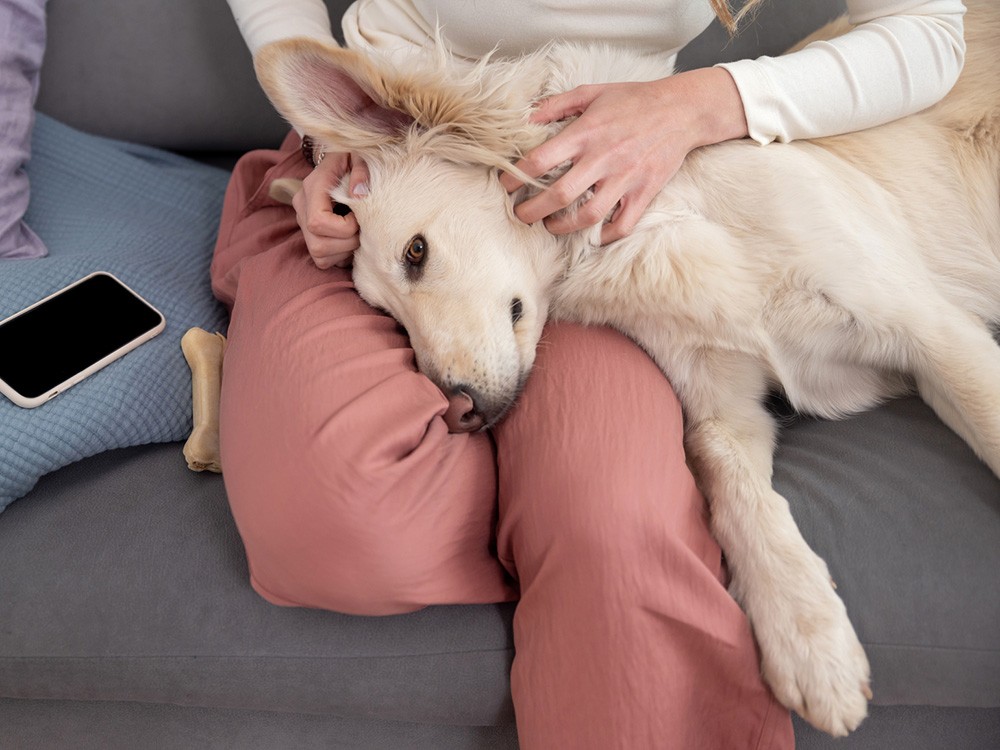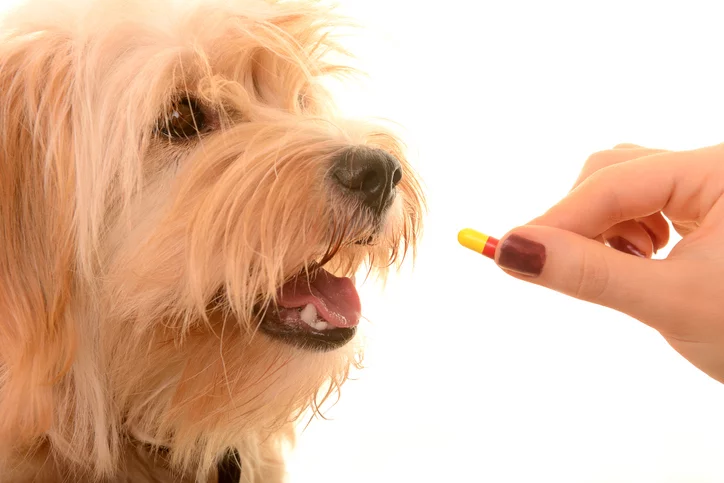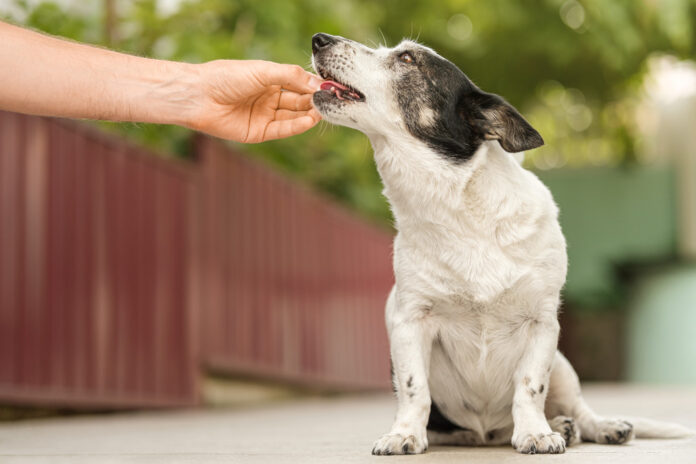Dogs are the most loved pets by humans. These creatures are anxious and energetic ones, and after all the fun sometimes they land up in the pool of trouble. The excitement leads them to anxiety, discomfort, and allergies. When your dog suffers from any allergic reaction, your immediate response is to reach your cabinets for medication, but it could be dangerous for your pet as humans and dogs react differently. You must immediately reach a veterinarian for medical assistance.
Most vets use diphenhydramine for dogs, also known as Benadryl. It helps treat travel anxiety, motion sickness, and other health issues. Always consult your veterinarian before giving your dog some human medication.
Let’s learn more about Benadryl and how much you must give it to a dog
What is Benadryl
It is a medication advised for the treatment of dogs when they suffer from mild to moderate infections or allergies. It is considered safe for dogs to treat sneezing, sickness, itching, and anxiety if it is given in proper dosage. It is really important to learn how much Benadryl can I give my dog.
Benadryl is an antihistamine medication that is used for treating allergies, such as sneezing, itching, runny nose, rash, and hives. It blocks the effects of histamine, a natural chemical that causes allergic reactions in the body.
It is available in the form of tablets, capsules, chewable, and liquid forms; it is important you introduce Benadryl to your dog after consulting it with the veterinarian dog.

Benadryl is proficiently accepted by dogs, but in some cases it may also cause side effects such as increased heart rate, urine retention, dry mouth, drowsiness, and loss of appetite. Sometimes, Benadryl doesn’t suit a dog well; it may end up causing allergic reactions, seizures, or low blood pressure. This happens rarely but it’s fine to be on the safer side. Instead of doing any experiment, consulting the doctor is the best way to cure your doctor.
Benadryl provides only temporary relief from symptoms; it’s not a permanent treatment.
How much Benadryl can I give my dog?
It’s very important that you learn about the required dosage for your dog as it depends on the health, age, and weight of your dog. What type of medication you are giving your dog is also important. Benadryl’s active compound is diphenhydramine, usually found in 25 mg tablets or capsules or in liquid form with 12.5 mg per teaspoon. The general rule to give your dog Benadryl is 1 mg of diphenhydramine per pound of body weight, twice or thrice a day. For example, a 25-pound dog can take one 25 mg tablet, or one teaspoon of liquid Benadryl, every 8 to 12 hours.
Do not give Benadryl to your dog without consulting a veterinarian as it may lay effect accordingly some dogs require less dosage depending on their health conditions while some may not be adaptive to the Benadryl and may react differently which may cause you trouble. Benadryl may not be safe for treating allergies of your dog, and it may react absurdly causing diarrhea, loss of appetite, increased heart rate, or difficulty breathing. If you find any signs of distress, then immediately consult your veterinarian.
Benadryl is not a pure treatment for your dog’s health issues; it’s fine for treating mild to moderate allergies. You may consult your vet if you do not see any sign of improvement in your dog, and follow other medications and treatments that are specifically appropriate for your dog. Dogs are the most lovable pets; nourish them with your love care, and proper health treatment.
Key points suggested for how much Benadryl can I give my dog.
- Benadryl is considered safe for most dogs.
- It is recommended to give 2-4 milligrams of Benadryl per kilogram of weight, or 0.9 to 1.8 milligrams per pound.
- You can calculate Benadryl dosage in milliliters (ml), take your dog’s weight in pounds (lbs), and divide it by 2.5.
- The liquid form of Benadryl is appropriate for dogs less than 10lbs and tablets are suggested for dogs with more than 10lbs of weight which come in 25-50 mg sizes; for better results break the tablet into small pieces and then give it to your dog.
- You know your dog and its medical history so starting with the lower dose and increasing it gradually would be very effective and best for your dog.

How much Liquid Benadryl can I give my dog
To treat your dog’s allergies, anxiety, and sickness, you reach for Benadryl, but you must know the correct dosage. If you are giving liquid form, then you must know how much Benadryl can i give my dog to calculate the proper liquid dosage of Benadryl for your dog, you must follow a simple formula. Firstly divide your dog’s weight in pounds by 2.5. You will get appropriate doors in millimeters for the 10-pound weight of the dog you get a dosage of 4 ml.
After calculating the proper Dosage, you know the exact amount to give your dog you can use a syringe or a measuring spoon for measuring 4 ml of dosage use a proper measuring spoon that holds the exact amount of dose.
How much Benadryl can I give to my 50 LB dog?
Generally, it is suggested to give two tablets of 25 mg, but it is necessary that you consult your veterinary doctor beforehand so that your dog gets proper treatment for certain conditions, as the dosage of medicine is suggested only after assessing the weight of your dog and other health conditions.
How long does it take for Benadryl to work on dogs?
There are several studies that suggest that it takes nearly 30 minutes for Benadryl to show its wonder, that it begins working within 30 minutes of dosage; it may take more time depending on various factors such as type, dosage, and the health condition of the dog. You must closely watch your dog after the dosage as it may work differently on your dog; some may experience effects a little slower while some may begin to feel alright really quickly, or some may become more hyperactive instead of sedation. Benadryl works as it should, but if you find any unusual change in your dog’s behavior, then you need to consult your veterinarian.
What happens if a dog has too much Benadryl?
Overdosing your dog may cause some symptoms to develop, it may cause serious Side effects. They are listed below:
- Dilated pupils
- Constipation
- Rapid heartbeat
- Behavioral changes, such as aggression, anxiety, or excitement
- Seizures
- Difficulty breathing
- Coma or death
If you notice any of the above-mentioned side effects or symptoms, then rush your dog to a veterinarian clinic as it could be life-threatening. The emergency clinic provides services that help your dog overcome an overdose of Benadryl veterinary-induced vomiting and provides supportive Healthcare service to your dog so that it may recover as soon as possible.
You can protect your dog by following the proper guidelines mentioned by your veterinarian doctor. Do not overdose on them; follow the proper dosage. Read the labels properly and ensure that it contains Diphenhydramine, the active compound present in Benadryl, as other compounds can be harmful to your dogs. Always keep medicines away from your dog’s reach as its overconsumption may risk their life and increase complications.

Does Benadryl make dogs sleepy?
Yes, giving Benadryl makes them sleepy as it’s one of the side effects of Benadryl that helps to calm down anxiety and hyperactivity. Well, this totally depends on the factors such as size, age, and health. Some dogs may react soon after the dosage, while some may not be affected at all therefore, it is suggested that before giving to your dog, consult your veterinarian and keep a close watch on your dog.
Side effects of Benadryl
Benadryl can have some side effects on your dog. Some of them are listed below:
-
Drowsiness and sleepiness
Your dog may feel lethargic sleepy, and drowsy after the dosage of Benadryl, and this affects their activity and behavior. Sedating your dog is helpful to calm them and release anxiety and restlessness. On the other hand, it could be dangerous if your dog needs to be active or alert. Avoid taking your dog for driving, hiking, or other activities that require attention and coordination after giving them the dosage of Benadryl.
-
Dry mouth
When you have a pet, you need to be attentive and cautious. Benadryl dosage can cause dry mouth, which reduces the production of saliva in their mouth and makes it difficult for them to swallow food; being a pet owner, you must know the symptoms that your dog has developed or experienced after getting a dosage of Benadryl make sure that your dog has access to fresh water at all the times after taking Benadryl.
-
Urinary retention
After the dosage of Benadryl, sometimes it may affect the bladder muscle of your dog, which makes it hard for them to urinate. This may cause infection in the urinary tract it may also develop discomfort and pain in the urinary system keep a close watch on your dog’s urination frequency.
-
Hypersalivation
Another side effect of how much Benadryl can I give my dog is hypersalivation, your dog does not contain dryness any more in its mouth, but it begins to drool too much which is a sign of vomiting, oral irritation, and nausea.
-
Increased heart rate
You must avoid giving banner drill to your dog if it is having any heart problems or high blood pressure as Benadryl stimulates the heart and makes it beat faster than normal.
-
Rapid breathing
Benadryl Can cause your dog to breathe faster or harder than normal. It begins affecting your dog’s respiratory system, which may give rise to anxiety, allergic reactions, and distress. Avoid giving Ban and a retired dog, and take it to your veterinary care immediately.
-
Vomiting
Benadryl can sometimes cause nausea and vomiting in dogs, especially if given on an empty stomach or in high doses.
You must also learn that if your dog has acquired any serious condition, then do not give Benadryl without consulting with the vet; some are listed below:
- Allergic lung disease
- Bladder neck obstruction
- Cardiac conditions (such as cardiovascular disease heart failure)
- Pregnant or nursing
- Glaucoma
- High blood pressure
- Hypertension
- Hyperthyroidism
- Low blood pressure
- Prostatic hypertrophy
- Seizure disorders
Is Benadryl Safe For Your Dog?
Benadryl is a worthwhile and safe medication for dogs if it is followed as per the guidelines of a veterinarian. If you are keeping the pet dog for the first time or you are already a dog owner then you need to keep a close watch on your pet after the medication. Keep in mind if there is any reaction, or your dog is doing any unusual activity. Keep the contact no. of a vet in your contact list so that you can call immediately for your queries and immediate response. Benadryl is considered safe for dogs for treating allergies, anxiety, discomfort, and sickness. Keep the human and canine medicines separate and out of threat to your children and pet animals. also, inform your family members about the medications.

Dosage Of Benadryl
There are some guidelines that reveal the approximate suggested dose for how much Benadryl I can give my dog; there are some deciding factors such as weight and health conditions. You can give 1 mg of Benadryl for every 1 pound of your dog’s weight twice or thrice a day, about 8 to 12 hours apart.
- Liquid: Benadryl in liquid form is not suitable for dogs because it contains alcohol. You must avoid giving it to your dog.
- Tablet: when Benadryl tablets are suggested for your dog, remember it contains 25 mg of Diphenhydramine (1 tablet for a 25 lbs. dog), and always check the dosage.
- Injection: it’s better that you get it done at the veterinarian clinic as he or she will inject it properly after administering all the symptoms. Injectable Benadryl is available in 10 mg/ml and 50 mg/ml.
Before giving Benadryl, be cautious and check properly that it contains only Diphenhydramine and is not compounded with other drugs such as Tylenol, as it may bring on some harmful side effects.
How much Benadryl can I give my dog is illustrated descriptively with the side effects? Your pet is your beloved, so taking care of its health is your responsibility; follow the guidelines given by your veterinary doctor while giving medicine to your dog. “A dog is the only thing on earth that loves you more than you love yourself.”

